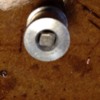Correct me if I'm wrong. The 3462 milk car used magnetic cans, while the 3472 used non-magnetic cans.
The reason I ask is that I just received a 3472 milk car and tested it on my test track. The cans were failing to drop into the lower portion of the discharge mechanism. After removing the body from the frame, I placed one of the cans against the portion of the chute where they begin to drop down to be unloaded. The can stuck to the outside of the chute. Viola ! I believe the seller sent me the wrong cans.
















